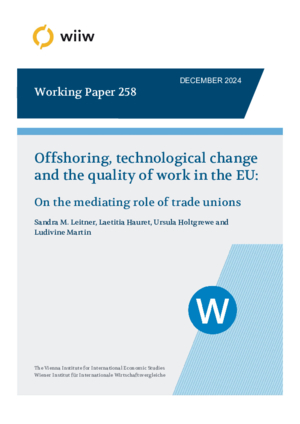Offshoring, technological change and the quality of work in the EU: On the mediating role of trade unions
Laetitia Hauret, Ursula Holtgrewe, Sandra M. Leitner and Ludivine Martin
wiiw Working Paper No. 258, December 2024
71 pages including 27 Tables and 3 Figures
This paper analyses the impact of different types of offshoring and technological change as well as the mediating role of trade union representation at the firm level on the quality of workers’ jobs in the EU in terms of atypical employment, which is further differentiated by type of atypical employment (i.e. temporary contracts and involuntary part-time work) as well as self-reported skills mismatch. It uses worker-firm-level data from the 2015 and 2021 European Working Conditions Surveys (EWCSs) merged with industry-level data on offshoring; the information and communication technologies (ICT) asset types of information technology (IT), communication technology (CT), and software and database (DB) technology; and robotisation. The results show that a worker’s likelihood of being in atypical employment is related to both forces analysed but in different ways, as there is a higher probability of being in atypical employment due to offshoring or IT but a lower probability of being in atypical employment due to CT. The two types of atypical employment are affected differently, with strong differences being found between workers in manufacturing and services industries. Both forces are of limited importance for workers’ self-reported skills mismatch and, as such, only temporarily lead to over-skilling in the case of offshoring but to under-skilling in the case of technological change. Trade union representation at the firm level only plays a limited mediating role in the likelihood that workers are either in atypical employment or report a skills mismatch.
Keywords: Trade unions, offshoring, technological change, atypical employment, skills mismatch, multilevel analysis
JEL classification: F16, F22, F66
Countries covered: EU28
Research Areas: Labour, Migration and Income Distribution
